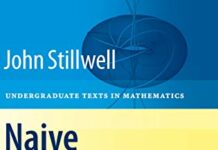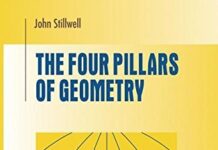
Ebook Info
- Published: 2003
- Number of pages: 268 pages
- Format: PDF
- File Size: 9.04 MB
- Authors: John Stillwell
Description
Solutions of equations in integers is the central problem of number theory and is the focus of this book. The amount of material is suitable for a one-semester course. The author has tried to avoid the ad hoc proofs in favor of unifying ideas that work in many situations. There are exercises at the end of almost every section, so that each new idea or proof receives immediate reinforcement.
User’s Reviews
Editorial Reviews: Review From the reviews:”Solving equations in integers is the central problem of number theory, so this book is truly a number theory book, with most of the results found in standard number theory courses. … The book is clearly written, well organized and is a very pleasurable reading: it is an excellent and very useful undergraduate textbook. However, thanks to the many examples and exercises, it is well suitable for independent study, as well.” (Lászlo Megyesi, Acta Scientiarum Mathematicarum, Vol. 71, 2005)”In this carefully crafted undergraduate number theory text, Stillwell walks the reader through the main topics that belong in any introduction to number theory … but he does so in a way that highlights the beguiling nature of number theory problems and keeps their rich history alive. … This book has some additional features that will draw you to order it for your courses. … Stillwell … presents a compelling argument for studying the ancient and modern problems of number theory … .” (Gwynneth G. H. Coogan, Mathematical Reviews, 2004 j)”A solid systematic introduction to (algebraic) number theory which is truly elementary in the sense that a bright young undergraduate could make rapid unaided progress through this book. … There are lots of goodies in the sidelines and the attention to clarity of writing and to pedagogic care give it a high rank amongst competing texts. … Stillwell’s book makes a very positive contribution to the coherence of the subject, which adds … to the satisfaction of studying it.” (John Baylis, The Mathematical Gazette, Vol. 88 (512), 2004)”Stillwell has taken very careful aim at his target audience and hit them squarely between the eyes. … the author has done a wonderful job of conveying his obvious love of the subject to the reader. … The author … covers basic classical number theory. … Each chapter opens with a substantial preview stating the central concepts which are about to appear. … In short, this book is a delight to read and is ideally suited to a beginning course in number theory.” (Ralph H. Buchholz, The Australian Mathematical Society Gazette, Vol. 31 (1), 2004)”The book is a concise introduction to number theory and some related algebra, with an emphasis on solving equations in integers. … The historical development has been followed where it helps to motivate the introduction of new concepts, but modern proofs have been used where they are simpler, more natural, or more interesting. … Also, this is the only elementary number theory book that includes significant applications of ideal theory.” (Zentralblatt für Didaktik der Mathematik, February, 2003)”The text would be suitable for the standard elementary number theory course. … could serve as an introduction to algebraic number theory. … has a number of unusual and attractive features. … there is much in this book that would make it an appealing choice for a group of able mathematics majors. … the book under review provides a valuable and original alternative to the many current texts on introductory number theory.” (David W. Boyd, SIAM Review, Vol. 46 (2), 2004) From the Back Cover This book is a concise introduction to number theory and some related algebra, with an emphasis on solving equations in integers. Finding integer solutions led to two fundamental ideas of number theory in ancient times – the Euclidean algorithm and unique prime factorization – and in modern times to two fundamental ideas of algebra – rings and ideals.The development of these ideas, and the transition from ancient to modern, is the main theme of the book. The historical development has been followed where it helps to motivate the introduction of new concepts, but modern proofs have been used where they are simpler, more natural, or more interesting. These include some that have not yet appeared in textbooks, such as a treatment of the Pell equation using Conway’s theory of quadratic forms. Also, this is the only elementary number theory book that includes significant applications of ideal theory. It is clearly written, well illustrated, and supplied with carefully designed exercises, making it a pleasure to use as an undergraduate textbook or for independent study.John Stillwell is Professor of Mathematics at the University of San Francisco. He is the author of several highly regarded books published by Springer-Verlag, including Mathematics and Its History (Second Edition 2001), Numbers and Geometry (1997) and Elements of Algebra (1994).
Reviews from Amazon users which were colected at the time this book was published on the website:
⭐Stillwell’s book Elements of Number Theory presents a grand picture, starting with solving integer equations, and then working into general solutions of the Pell Equation. He covers basic ground, but without the generally random approach that most Number Theory books present. In particular, he stresses repeatedly the importance of Unique Factorization, and in many ways his book is a build up to how Unique Factorization is “saved” in general algebraic structures by Prime Ideals. That by itself makes it worthwhile, because it is bringing in very important topics from Modern Algebra that are used in modern number theory. This is especially true because that angle is missing from several introductory texts on the subject (such as Dudley’s classic text). Great exercises, clear writing, and motivating discussion also gives the reader all important context. Too many number theory books show random results which, while pleasing, seem arbitrary. Here is a coherent development of deep ideas and a striking big picture. I am definitely glad to have it on my shelf.
⭐I enjoy the algebraic approach to number theory.
⭐This is a very pleasant introduction to number theory. Each chapter is preceded by a preview and concluded by a discussion to make the main ideas clear and well-motivated and to show how things fit in the big picture by discussing the historical development. The book starts with the very basics and moves via some pearls like the four square theorem and quadratic reciprocity to a culmination with algebraic number theory. A readable and elementary introduction to algebraic number theory is especially valuable today because, as Stillwell argues in his preface, this is the proper setting in which to learn of rings and ideals. Nowadays, of course, the custom is to pull these concepts out of a hat in the mysterious context of “abstract algebra” where there is no apparent reason to introduce them whatsoever. Fortunately, Stillwell has provided us with an equally enjoyable book on algebra, so now we can only hope that some day the curricula will change accordingly.
⭐After reading the first couple of chapters of Mr. Stillwell’s book on number theory I’ve made plans to purchase his other college-level textbooks, including Elements of Algebra, Real Numbers, Four Pillars of Geometry, and, recently, Reverse Mathematics. I’m a mathematically-minded CS student and my interests fit very nicely with Mr. Stillwell’s, plus I enjoy his style tremendously. Book is perfect for self-study.
⭐One of the best introductory books I’ve seen. It is concise, and yet very illuminating and down to earth, leading very nicely into the beginnings of algebraic number theory.
⭐The whole book is centred on understanding vector spaces and linear mapping without recourse to determinants which are left to the end of the text. By the time you have finished the book you will certainly having a thorough grounding in this important topic. It is highly abstract but avoids the axiom, proof, theorem recipe often found in books covering Linear Algebra. The author does point out that this is written for an readership that has already met the subject in a previous course. It will certainly suite undergraduates in their second or third year or for casual readers who are more familiar with vectors in Euclidian space. Thoroughly recommended.
⭐excellent book
Keywords
Free Download Elements of Number Theory (Undergraduate Texts in Mathematics) in PDF format
Elements of Number Theory (Undergraduate Texts in Mathematics) PDF Free Download
Download Elements of Number Theory (Undergraduate Texts in Mathematics) 2003 PDF Free
Elements of Number Theory (Undergraduate Texts in Mathematics) 2003 PDF Free Download
Download Elements of Number Theory (Undergraduate Texts in Mathematics) PDF
Free Download Ebook Elements of Number Theory (Undergraduate Texts in Mathematics)



